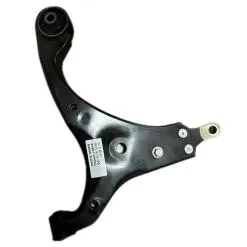driver side upper control arm
Understanding the Driver Side Upper Control Arm Importance, Function, and Replacement
The driver side upper control arm is a critical component of a vehicle’s suspension system, playing an essential role in ensuring smooth handling, stability, and overall vehicle performance. This article will explore the function of the upper control arm, its significance in automotive design, common issues that may arise, and guidance on replacement.
What is the Upper Control Arm?
The upper control arm is a pivotal part of the suspension assembly, connecting the vehicle's chassis to the wheel hub. Generally, vehicles are designed with control arms in pairs – upper and lower. The driver side upper control arm specifically pertains to the left side of the vehicle in most countries where vehicles drive on the right.
The primary function of the upper control arm is to allow the wheel to move up and down while controlling its alignment during various driving conditions. This movement is essential to maintain tire contact with the road, ensuring safe cornering and braking stability.
Importance of the Upper Control Arm
1. Handling and Stability The upper control arm influences the vehicle’s handling characteristics. It impacts the camber angle (the tilt of the wheel) and helps in maintaining necessary alignment during both straight-line driving and cornering. A well-functioning control arm provides better handling, resulting in improved responsiveness and comfort.
2. Tire Wear Proper suspension geometry is crucial for even tire wear. If the upper control arm is damaged or misaligned, it can cause uneven tire wear, affecting driving safety and requiring costly replacements.
3. Ride Quality A functioning control arm absorbs shocks from bumps and potholes. When the upper control arm fails, drivers may experience a rough ride, reduced comfort, and an overall decrease in vehicle performance.
Common Issues with the Upper Control Arm
Several problems can affect the driver side upper control arm, leading to performance issues and safety risks
1. Wear and Tear Over time, components of the upper control arm, such as bushings and ball joints, can wear out. This wear can lead to loose connections, contributing to poor handling and suspension noise.
2. Corrosion Rust and corrosion can particularly affect control arms in regions with harsh weather or road salt exposure. Corroded control arms are weak and may break, resulting in a significant safety hazard.
driver side upper control arm

3. Impact Damage Accidents or driving over large obstacles can bend or damage the upper control arm. A bent control arm can severely impact wheel alignment and handling, necessitating immediate replacement.
Signs of a Failing Upper Control Arm
It’s crucial for drivers to recognize the signs of a failing upper control arm to address issues before they escalate
- Unusual Noises Clunking sounds when driving over bumps can indicate damaged bushings or ball joints. - Pulling to One Side If the vehicle pulls to one side, it may be due to alignment issues caused by a failing control arm. - Uneven Tire Wear Drivers should regularly check their tires for uneven wear patterns, which can signify suspension problems. - Vibration While Driving Excessive vibration can indicate worn suspension components, including the upper control arm.
Replacement of the Upper Control Arm
If failure is detected, replacing the driver side upper control arm is essential for ensuring continued vehicle safety and performance. Here’s a brief overview of the replacement process
1. Diagnosis A thorough inspection should be conducted to confirm the issue. Mechanics typically check for play in the control arm, inspect bushings, and evaluate the overall condition of the suspension.
2. Removal To replace the upper control arm, the vehicle must typically be raised, and the wheel removed. The control arm is then disconnected from the steering knuckle and the chassis.
3. Installation The new upper control arm is installed, ensuring that all bolts are torqued to the manufacturer’s specifications to guarantee safe handling.
4. Alignment Finally, after replacing the control arm, a wheel alignment is necessary to restore proper handling and tire wear.
Conclusion
The driver side upper control arm is not just a simple component of a vehicle; it’s vital for safety, handling, and ride comfort. Understanding its function and recognizing the signs of wear can save drivers significant expense and ensure safe vehicle operation. Regular maintenance and prompt attention to suspension issues will lead to a safer and more enjoyable driving experience.









